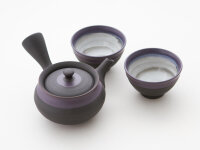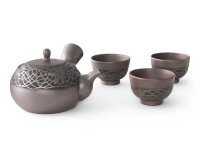
Japanese Tea Ceremony
In the early 17th century, tea arrived in East Frisia and significantly competed with the local beer consumption. In the mid-17th century, tea arrived in England, imported from India, and became a very popular drink among the upper class.
In England and East Frisia, tea is prepared in very similar ways. Often, strong tea varieties are steeped, and the tea, either as loose leaves or tea bags, remains in the pot. Typically, these teas, which became stronger as a result, are diluted with more hot water. Milk as an addition is common in England, while in East Frisia, tea is poured over a piece of rock candy and enhanced with some cream.
Many of the teas consumed in Europe are flavored. However, in recent times, pure varieties are becoming more popular. In all countries and cultures, the tea ceremony is associated with gatherings of people or welcoming guests. However, there are significant differences in its expression and the true purpose of the tea ceremony. Ostfriesische tea blends are well-known. Both in England and East Frisia, black tea is typically consumed, especially Assam varieties.
The Tea Ceremony in Asian Countries
In China and Japan, there is a close connection between the tea ceremony and meditation. But what about Tibet? Tibetans drink milk tea or butter tea, a tea with salt and butter. The butter comes from the milk of the local yak. The tea - essentially green tea - comes from China. Historically, Tibetans traded horses with the Chinese for tea, and even the trade route was named accordingly. Butter tea (green tea with salt and butter) provides warmth, nourishment, and aids digestion. Butter tea is a crucial beverage for people living in this extreme climate zone, mainly subsisting on yak meat.
Green tea is a beverage, while butter tea is more of a food. Even today, in China and Japan, green tea is treated more delicately, whereas in Tibet, tea bricks are still used, which are tea leaves pressed into planks. The green tea is then pulverized, resembling Matcha, as consumed in Japan. Afterward, the tea powder is boiled for an extended period in kettles along with water. Only then is the tea concentrate mixed with salt and butter, heated again, and served.
The tea ceremony closest to the Japanese one is the Chinese. In China, there are tea schools, three in number, which set the direction for the art of tea preparation. Initially, it was powdered tea with some salt, then powdered tea mixed with hot water and frothed (Matcha). Whole tea leaves, usually from Oolong tea, came into use later with the "School of Fragrant Leaves."
The preferred tea is Oolong tea, a semi-fermented tea that leans towards green tea in taste but should not oxidize at all. In Japan, green tea, following the philosophy of purity and minimalism, is consumed very pure. This means that green tea derives its strength and flavor solely from itself - no additives - so it's only natural that green tea from Japan is relatively high-priced.
The Japanese Tea Ceremony, or Correctly: The Way of Tea
Japan has always had a tendency to examine, refine, and improve. One might even say to take things to the extreme, but that wouldn't do justice to the seriousness with which the Japanese approach the subject. It's more about delving to the core, exploring depth, and gaining insights. So is the Japanese development of the tea ceremony with green tea.



Green tea is grown in some countries, but no tea-producing country has refined and cultivated the rules for the preparation and tea preparation as much as Japan has. The cultural development in Japan went so far that the term "tea ceremony" must be considered incorrect. Even though this term is still commonly used in the rest of the world, for this ancient Japanese cultural tradition, Teeweg (Chado) or the Way of Tea is the correct term.
It's about a path one walks to achieve a new state of consciousness. It was developed in Japan based on the ways of Zen Buddhism. The goal is harmony with inner and outer nature, something sought for oneself and made possible for guests. The enjoyment of green tea and Matcha is actually just a means to an end.
As complex as the rules may be, dictating how the tea path should be walked, in reality, this tradition is also characterized by minimalism. Concentration on the essentials, simplicity, and harmony are the pillars of Chado. Probably, this orientation, which also corresponds to a need and trend in the Western world, contributes to the growing enthusiasm in Europe for green tea from Japan, for Matcha, and the associated philosophy.
Influences of this minimalism can be found in Western design, architecture, and art. The Japanese style of living, also characterized by simplicity with the aim of inner reflection, is gaining more and more fans. The rules for shaping Chado, even the procedure for preparing and drinking a fine, often rarer and high-priced green tea, require attention. It is precisely this attention, necessitated by complex processes, that could be seen as a means to an end.
The purpose is inner reflection, distance from the everyday, finding peace, coming to oneself, resulting in increased awareness and mental recovery. Harmony can be seen as the antithesis to haste and chaos, unconscious haste, and careless thoughtlessness. Chado helps and is the path to oneself.
The Invitation to Self-Reflection with Green Tea
In Japan, it is customary to walk the tea path together, along with guests. The gathering to enjoy some delicious food and drink the fine matcha follows rules set by the schools of the tea path.
Chado is one of the arts of Japan, with Shogu, a Buddhist abbot, considered its forefather. Inspired by Shogu, Ashikaga Yoshimasa, a shogun and his lord, retired from government offices and devoted all his attention to the arts, including the tea path.
The ideas about how the Japanese tea ceremony should take place, in what environment it should occur, and how these places should be designed, vary and have changed over time. However, the basic structure of how green matcha tea is enjoyed has remained essentially the same. Politeness, respect, regard, and hospitality are high values in Japan.
So it's understandable that the host and tea master prepare the ritual art of the tea path well to be able to celebrate Chado as perfectly as possible. For him, it's not about drinking the best matcha tea in society, this is not the real purpose. Instead, it's about offering guests the opportunity to find inner reflection, and the preparation and seriousness are expressions of his respect and politeness.
The Garden Path
The path of green tea or green gold begins with the garden path. Guests are welcomed in a waiting room in the garden with hot water, which is used for later tea preparation.
Walking through the garden, a place of relaxation and enlightenment, serves as a departure from everyday life. The first stage of enlightenment is significant as a preparatory phase.
Back in the garden, guests find themselves at a waiting bench, often an open pavilion. Here, they have the opportunity to purify themselves. While guests cleanse themselves, a process that has more to do with mental purification than physical dirt, the host makes the preparations in the tea house.
Guests enter one by one, bowed or on their knees, humble and full of reverence. Everyone is considered equal; societal ranks and positions no longer hold any validity.
The Procedure in the Tea House
Now, food is served, vegetables, soups, and, of course, rice. Sake is also drunk. The tea master then places charcoal on the fire to heat the tea water later. Once the Kaiseki, the name for the meal, is finished, the guests return to the waiting room. Only when the gong has been struck five times do they re-enter the tea room. The door is closed, and the host begins his preparations.
He brings the important tea utensils on a tea tray and arranges them thoughtfully. The tea bowl is filled with the right amount of tea powder. Now he adds hot water and stirs the tea with a bamboo whisk until a creamy froth forms. The tea bowl is turned three times, and the guests admire it.
The tea bowl goes through the guests one by one, is closely examined, and drunk from. It is customary to comment on the design, the temperature, and the taste. The tea bowl is wiped and returned to its place.
Now it's time for the sweet. It is eaten before drinking tea. The host places the sweets in a special container, and each guest receives one. The host and guests bow to each other, which symbolizes the end of the tea meeting.
The Tea House
The tea house is usually a simple building, which the host has built specifically for the tea meetings. A small entrance, in which you have to bow down, allows access to the tea house. The entrance is an equalizer; all guests must bend over.
Inside, there is room for only a few guests. The small room helps create an intimate atmosphere and allows for close encounters and personal encounters. Light is provided by a small window, and the garden is often visible through it. The tea house is a place of refuge from the outside world.
The tea master has paid attention to all the details in the tea house. The tea room is empty, except for a scroll with an inspirational saying on the wall. The scroll symbolizes the essence of the tea meeting and the quest for truth. The host has selected it carefully and has a reference to the season.
The bamboo utensils and the tea bowl, which is an heirloom, are also chosen with care and have a specific meaning. The tea bowl is a work of art, valuable, and with a long history. Every time a guest drinks from it, it is an honor.
Everything in the tea house has a meaning. Everything is a symbol. Everything is designed to help the guest to find their inner peace. The tea house is a small world, a sanctuary, a place where one can be oneself.













